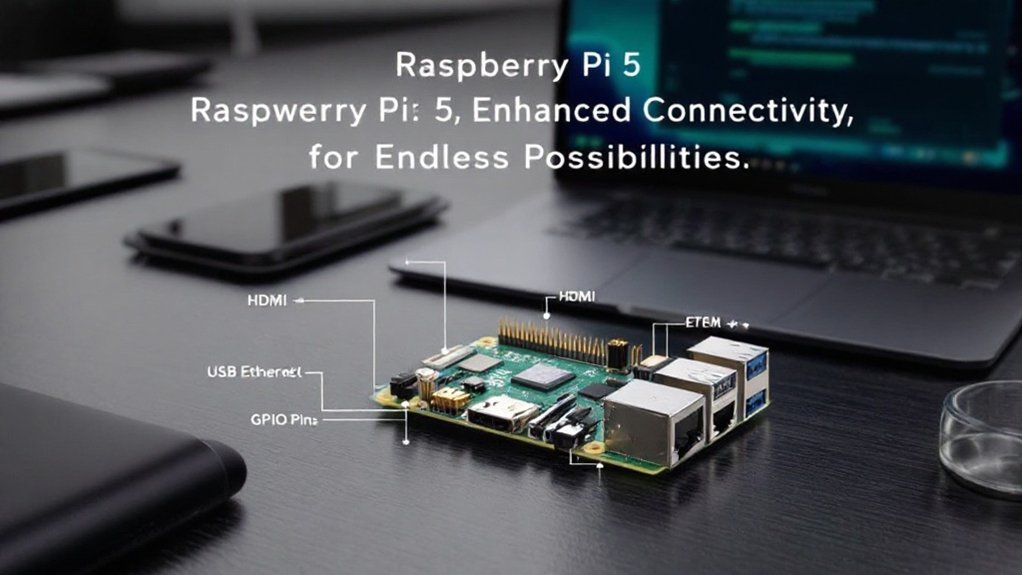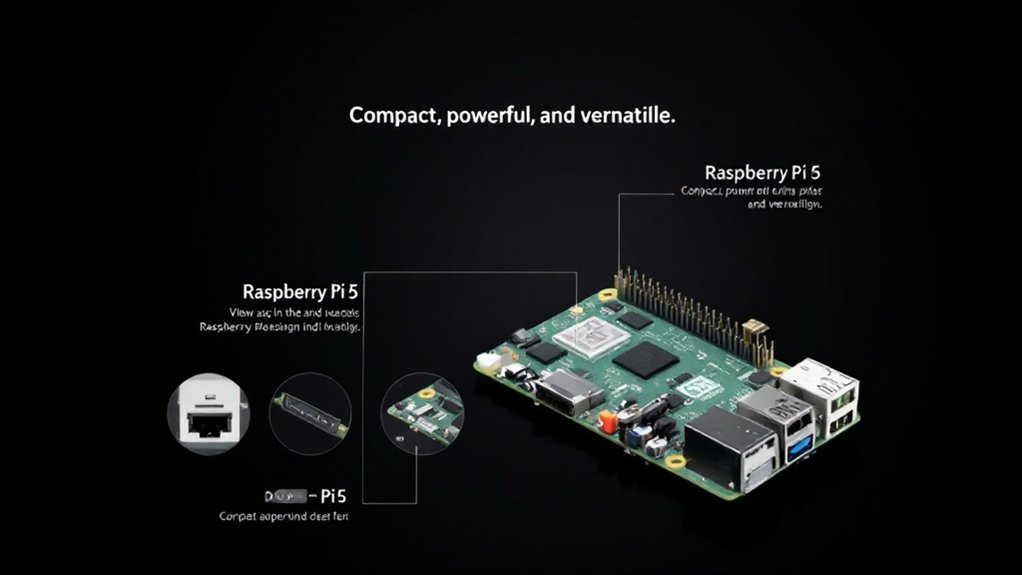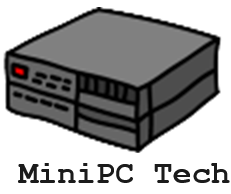The Raspberry Pi 5 is a substantial upgrade with its 64-bit quad-core processor and improved RAM options, delivering up to 50% better performance than its predecessor. You’ll appreciate the dual 4K HDMI outputs and versatile USB 3.0 ports, making it perfect for multimedia and demanding tasks. Connectivity is robust with dual-band Wi-Fi and Bluetooth 5.0, plus a PCIe interface for high-speed peripherals. While it excels in power efficiency, note that it can run hot under heavy loads. Overall, it’s versatile for projects from IoT to education. Stick around to uncover what else this device offers.
Note: The Raspberry Pi is NOT a “product” as the Raspberry Pi Foundation does NOT sell computers.
Key Takeaways
- The Raspberry Pi 5 features a powerful 64-bit Arm Cortex-A76 quad-core processor, offering a significant performance boost compared to Raspberry Pi 4.
- With memory options of 4GB, 8GB, and potential for 16GB, it supports demanding applications and multitasking efficiently.
- Enhanced connectivity options include dual-band Wi-Fi, Bluetooth 5.0, and multiple USB 3.0 ports for versatility in project development.
- Its dual 4K HDMI outputs driven by VideoCore VII GPU enable high-quality graphics rendering for multimedia projects.
- The compact design and user-friendly interfaces make it suitable for educational purposes, IoT applications, and hobbyist experimentation.
Hardware Specifications
When you plunge into the hardware specifications of the Raspberry Pi 5, it’s clear that this model has undergone substantial upgrades. At its core, you’ll find a powerful 64-bit Arm Cortex-A76 quad-core processor, clocked at an impressive 2.4 GHz. This change boosts performance by up to 50% compared to the Raspberry Pi 4, ensuring smoother processing for demanding applications. Additionally, the Raspberry Pi 5’s performance metrics are comparable to those of previous generations, showcasing significant advancements in processing capabilities.
One of the standout hardware upgrades is the memory configuration. The Raspberry Pi 5 offers versatile memory options, launching with 4GB and 8GB variants, and the potential for 16GB. Incorporating LPDDR4X-4267 SDRAM, it provides speedier data access, which is essential for applications like media streaming and machine learning. This enhanced memory also supports better multitasking capabilities, similar to those achieved with optimization strategies on earlier models. The memory bandwidth, such as the theoretical memory bandwidth of 11.9 GiB/s seen in previous models, has been optimized for even more efficient data transfer.
Storage solutions remain expansive; a micro SD card slot accommodates up to 2TB, while USB 3.0 ports allow connections for SSDs or flash drives, further enhancing performance.
The dual 4K HDMI outputs, powered by the VideoCore VII GPU, allow for high-quality graphics rendering. All these enhancements position the Raspberry Pi 5 as a compelling choice for innovators looking to harness more power and versatility in their projects, particularly for tasks requiring Gigabit Ethernet connectivity.
Connectivity Options

The Raspberry Pi 5 offers a thorough range of connectivity options that cater to modern needs and enhance project versatility. Its 1Gbit Ethernet port provides solid performance, with maximum throughput that suits various applications.
Though it’s outpaced by alternatives like the Radxa ROCK 5B, which features 2.5Gbit Ethernet, the Pi 5 still holds its ground with the possibility of higher speeds through USB Ethernet adapters, enhancing its Ethernet advantages.
On the wireless front, the inclusion of the Infineon CYW43455 Wi-Fi chip heralds significant Wi-Fi enhancements. While maintaining dual-band 802.11ac support, the upgraded SDIO interface optimizes performance, leading to improved speeds over the previous model. Furthermore, the Raspberry Pi 5’s enhanced processing power allows it to handle demanding connectivity applications with ease.
However, some users might question the signal strength at larger distances, with real-world speeds hitting around 90-100 Mbps as an access point. Additionally, the Raspberry Pi 5’s improved microSD card performance has led to faster read and write speeds, further enhancing its data handling capabilities.
Moreover, the single-lane PCIe 2.0 interface lets you connect high-speed peripherals, including NVMe drives. Coupled with Bluetooth 5.0 support and upgraded USB3 Type-A ports, the Raspberry Pi 5 guarantees ample options for innovative projects.
To summarize, its connectivity setup strengthens its versatility and functionality within your creative endeavors.
Performance Benchmarks

With robust connectivity options established, the Raspberry Pi 5‘s performance benchmarks reveal a notable improvement over its predecessor, the Raspberry Pi 4.
With regard to single-core performance, the Raspberry Pi 5 achieves Geekbench 6 scores of 764 and 774, showcasing a remarkable 2.4x speed increase compared to the 340 score of Raspberry Pi 4. This single-core comparison highlights the efficiency of the upgraded quad-core Arm Cortex-A76 processor clocked at 2.4 GHz. Additionally, the Pi 5’s overall architecture provides a significant enhancement in processing capabilities compared to older models.
Moving to multi-core analysis, Raspberry Pi 5 scores 1604 in multi-core tests, translating to a 2.2x speed boost over Raspberry Pi 4. The recent benchmarks also indicate that the Pi 5’s performance improvement of approximately 100x over the last decade positions it as a leading option in compact computing.
You’ll notice a similar trend in Sysbench multi-threaded tests, where the Raspberry Pi 5 reaches 4165 MBps—an impressive 1.49x increase from its predecessor.
Both single-core and multi-core benchmarks reveal that Raspberry Pi 5 consistently performs better, whether it’s in stress-testing scenarios or more practical applications.
Importantly, the Raspberry Pi 5 processes multi-core workloads with three times the efficiency of the Raspberry Pi 4, making it an innovation that’s hard to overlook.
Power Efficiency

Examining the power efficiency of the Raspberry Pi 5 reveals both improvements and challenges compared to its predecessor.
While it delivers superior performance, the energy consumption figures warrant your attention.
Here’s a look at the specifics:
- Higher idle power consumption, ranging from 2.2-2.7 Watts
- Noticeable thermal management issues, reaching up to 86.7°C under stress
- Enhanced computational capabilities lead to increased power usage
- The potential for significant power savings with custom configuration settings
- An active cooling solution can mitigate power drain when under load
- Setting POWER_OFF_ON_HALT=1 can significantly reduce energy usage during shutdown, allowing for nearly 0.01 Watts.
Interestingly, the increase in idle power consumption was noted after the recent kernel update on January 31, 2024.
At idle, the Raspberry Pi 5 consumes more than the Raspberry Pi 4.
Under heavy workloads, it can draw as much as 7 Watts, and thermal throttling kicks in at 82°C, reducing CPU speed.
Curiously, optimizing the power settings can enhance efficiency, allowing you to lower the consumption during shutdown to nearly 0.01 Watts.
Design Features

Raspberry Pi 5 showcases a robust array of design features that elevate its functionality markedly over previous models. Its design aesthetics, with a sleek exterior and thoughtful layout, enhance both its visual appeal and practical use.
You’ll appreciate the improved user ergonomics, especially with the addition of two USB 3.0 ports alongside the standard USB 2.0 connections, enabling quick data transfer and peripheral connectivity.
The powerful 2.4GHz quad-core Arm Cortex-A76 CPU guarantees smoother multitasking and rapid data processing, critical for applications like AI and machine learning. This enhancement is complemented by a significant boost in data processing speed, ensuring more efficient handling of complex tasks. Additionally, the Raspberry Pi 5 can be purchased with multiple RAM options, further tailoring its capabilities to user needs.
The dual 4Kp60 HDMI outputs with HDR support cater to high-resolution needs, making it perfect for demanding visual tasks.
Moreover, the inclusion of Gigabit Ethernet and dual-band 802.11ac Wi-Fi enhances connectivity, while PCIe 2.0 support allows for future expansion with high-speed peripherals.
The RAM options of 4GB and 8GB provide flexibility for various projects. With a microSD card slot supporting high-speed SDR104 mode, you’re set for peak storage performance.
To conclude, the Raspberry Pi 5‘s design features foster an innovative environment for tech enthusiasts and creators alike.
Frequently Asked Questions
What Operating Systems Are Compatible With Raspberry Pi 5?
You’ll find various Raspberry Pi software options compatible with the Raspberry Pi 5, like Raspberry Pi OS, Ubuntu, and Arch Linux. Their distinct features cater to different needs, enhancing your experience through customization and performance improvements.
Can I Use Raspberry Pi 5 for Gaming?
Can you imagine gaming with the Raspberry Pi? It excels at game emulation for classics like Dreamcast and GameCube, but struggles with demanding titles. For an ideal experience, consider using an external GPU for enhanced performance.
Is Raspberry Pi 5 Suitable for Machine Learning Applications?
Yes, the Raspberry Pi 5 excels for machine learning applications, supporting advanced frameworks with its impressive performance benchmarks. Its powerful CPU and enhanced RAM enable efficient processing, making it ideal for innovative AI projects.
What Is the Maximum Supported MicroSD Card Size for a Raspberry Pi 5?
While microSD speed and storage capacity are essential, the maximum supported microSD card size is theoretically 2TB. Higher capacities exist, but practicality often favors cards up to 500GB for effective performance and cost-efficiency.
How Does Raspberry Pi 5 Compare to Raspberry Pi 4?
When you compare the Raspberry Pi 5 to the 4, you’ll notice significant performance benchmarks showing 2-5 times faster speeds. Despite slight price differences, the enhancements in speed and capability offer great value for innovative projects.
Conclusion
To conclude, the Raspberry Pi 5‘s stellar specifications, significant speed, and satisfying design make it a standout choice for enthusiasts and developers alike. Whether you’re diving into DIY projects or demanding applications, its robust performance and reliable connectivity cater to your needs. Plus, with its power-efficient prowess, you can enjoy prolonged projects without worrying about excessive energy consumption. Overall, this remarkable microcomputer really raises the bar, proving it’s more than just a tiny tech toy.

I am a retired software engineer with experience in a multitude of areas including managing AWS and VMWare development environments. I bought a relative a mini-PC a year ago and have become passionate about the technology and its potential to change how we deploy software.

